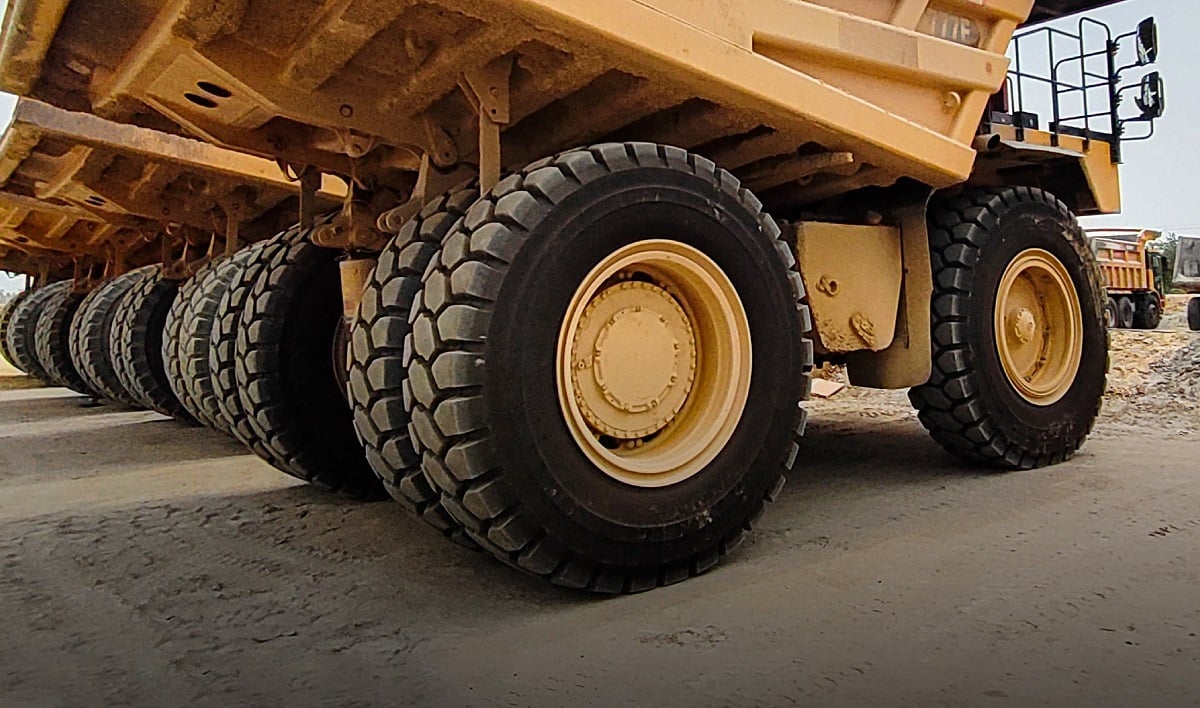The Cost of Mismatched Dual-Position Tires
Minimizing the Effects of Mismatched Tires on Construction and Mining Equipment
It’s common to see dual-wheel configurations on construction and mining equipment—they provide superior stability, are adept at handling heavy loads, and produce exceptional traction even in soft and slick terrain. While duals offer a number of advantages to fleet owners and operators, they also add a few unique challenges, the most notable of which is the need to ensure that tires in the dual position match, no small feat considering the conditions these tires commonly work in.

Mismatched Dual-Position Tires
It’s frequently said that running mismatched dual tires is a good way to destroy two tires for the price of one. Mismatched dual tires most often occur when a damaged tire is removed for repair or replacement and the remaining tire is left installed. This can lead to problematic situations, such as mixing new with worn tires, radial with bias tires, and/or tires with different tread patterns, tread depths, outer diameters, rolling circumferences, etc.
Why Mismatched Tires Don’t Work
Dual-position tires are designed to work together, however, when tires are mismatched and their ODs don’t align, they work against each other. Consider that when a tire with a smaller OD is paired with a tire with a larger OD, the smaller tire needs to rotate faster to travel the same distance as the larger tire, while more of the load is placed on the larger tire.
The outcome of operating mismatched dual-position tires can manifest itself in a number of ways, none of them good. For example, the extra load placed on the larger tire can cause increased heat buildup—heat is the number one enemy of tires—and lead to separations. The extra load placed on the larger tire can also make it more susceptible to impact breaks and cuts, common threats to the majority of construction and mining equipment. Because the smaller tire rotates more than its larger counterpart, it can suffer from irregular or accelerated wear.
Since drivetrains are engineered to move tires at the same speed, mismatched tires can also wear and damage equipment transmissions and differentials. In the end, it all adds up to more maintenance, increased downtime, shorter tire service life, and added expense.
Other Issues Caused By Mismatched Dual Tires
Increased wear and tear on equipment and short-lived tires are the most prominent problems posed by mismatched dual-position tires, but they’re not the only ones. Mismatched dual tires mean the smaller tire is basically getting dragged along, which requires extra energy and adds up to larger fuel expenditures. Mismatched tires can also compromise handling, making equipment less productive and more dangerous to operate.
How Dual Tires Are Designed to Work
Dual tires are designed to work together and are ideally mounted concurrently, operated at identical inflation pressures, wear evenly, and deliver the same service life. Even small differences in dual tires can lead to greater tire wear and a loss of equipment performance. Working with your local tire dealer or rep to establish a tire rotation program is an excellent strategy for maximizing your investment in tires.
Mixing New and Worn Tires
Ideally, OTR tires are mounted at the same time, however, that’s not always the case, such as when a damaged tire requires replacement. When changing a dual-position tire in need of premature replacement, it’s wise to replace both tires simultaneously. If replacing just one tire, it’s highly recommended that it’s changed out with a matching used tire—that is, the same brand and model of tire with similar tread depth and OD. Keep in mind, a worn-out tire installed next to a new tire can increase the load by 55% on the larger tire.
Inflation Pressure
It’s extremely important to maintain the inflation pressure of dual-position tires, as even minor variances in PSI can cause otherwise identical tires (the same make, model, tread depth, and diameter) to mismatch. A difference of just 10% in the air pressure of dual-position tires equates to an 11% difference in the load carried by each tire.
Radial vs. Bias-Ply
Radial tires and bias-ply tires are built differently. Radial tires are constructed and operate in two parts and feature plies that run perpendicular to the circumference of the tire. Conversely, bias-ply tires are built as a single working unit with plies that criss-cross, commonly at 45-degree opposing angles.
Because the two types of tires have their own unique construction, they work differently. Radial tires deflect more than their bias-ply counterparts. If a radial and bias tire are used together in a dual position, the bias tire will bear more load, adding to its natural tendency to wear faster.
Yokohama Off-Highway Tires America
Tires play an important role in today’s construction and mining industries. Yokohama Off-Highway Tires America premium Yokohama OHT tires deliver application-specific solutions to help customers meet the real-world challenges facing them and help them improve everything from productivity to fuel consumption to tire longevity. Whether you’re looking for a dual-position or single-position tire, want to learn more about our impressive product line, or need a hand establishing a tire maintenance program, contact your local dealer or rep.
Comments
Post a Comment